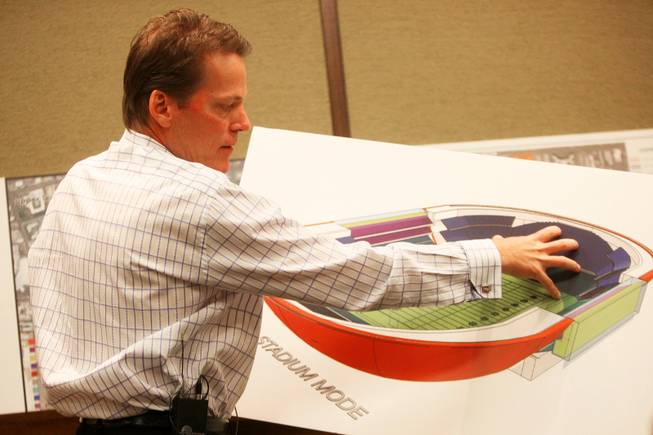
Silverton CEO Craig Cavileer discusses Majestic Realty’s latest plans for a new arena/retail/residential project on UNLV’s campus in the executive offices at the Silverton on Tuesday, June 28, 2011.
Saturday, May 26, 2012 | 2 a.m.

Silverton President Craig Cavileer

UNLV President Neal Smatresk
- Negotiations extended for UNLV stadium project (12-1-2011)
- Developers: A UNLV stadium could be built without raising taxes (9-13-2011)
- Developers continue push for UNLV stadium, retail district (6-28-2011)
- Just build it already: Why Las Vegas can’t land a pro sports team (4-18-2011)
- Developers put early plans for UNLV stadium, retail district on display (2-1-2011)
- Regents to hear UNLV arena plan for football, basketball (1-31-2011)
- Mayor: UNLV domed stadium wouldn’t conflict with a downtown Las Vegas arena (1-27-2011)
- Report: UNLV domed stadium plans will be unveiled Tuesday (1-27-2011)
- Goodman: Arena project a key issue for next Las Vegas mayor (1-20-2011)
- UNLV acknowledges effort to bring stadium, football to campus (1-19-2011)
Sun archives
The expected approval this coming week of an agreement between UNLV and private developers will end 15 months of preliminary planning and open the door for the inking of hard-and-fast plans for a campus project that includes 4,000 living units and and a 60,000-seat stadium.
Called “UNLV Now,” the 150-acre project also will include a retail area known as a student village. If the university system’s Board of Regents approves an exclusive negotiating agreement between UNLV and Majestic Realty Co., the next step will be returning in November for approval of a new campus master plan.
Then, if the Legislature quickly approves a tax-incremental financing district for the project early in its 2013 session, Craig Cavileer said construction likely will begin in 2013.
Cavileer, Silverton resort president and Majestic’s project representative, said the project was “pivotal” for the evolution of the university, which is slightly more than 50 years old.
“We’re really changing things for the next 100 years,” Cavileer said.
When the project is completed, UNLV President Neal Smatresk said, it will be “the most exciting college facility ever built in the United States.”
For the campus, he added, “this is the transformational step we need.”
University overseers will get the chance to approve a negotiating agreement Friday. If approved, it will provide more assurance to Majestic that the university is serious, that it wants this project done. Approval will allow Majestic to spend what is estimated to be millions more working on details of the project — timelines, costs, logistics.
Broad details about the project have changed over 15 months. Cavileer said the most current vision is for the 1.1 million-square-foot stadium/event center to have 52,000 permanent seats but to be expandable to 60,000. UNLV football games would be played there but Rebel basketball games still would be at the Thomas & Mack Center, which would be overhauled and renovated as part of the project. Last year, the Sun reported the project’s estimated cost at $2 billion. Cavileer would not offer an estimate but said the project would be less expensive than any of the Strip’s newer casinos.
The event center would take about 30 months to complete. Whether it would be built concurrently with the living units and student village are details Cavileer said still needed to be solidified.
The temperature-controlled, covered event center, which would be kept at 70 degrees, would qualify Las Vegas for large events that it couldn’t attract previously, including major league soccer, the NCAA’s basketball Final Four, political conventions, perhaps multiple college football bowl games, even NFL preseason games.
“There’s been plenty of discussion” about NFL preseason games, Smatresk acknowledged. “Some of it is fairly advanced. Right now, though, it’s all in the realm of speculation until we can lock in all the planning.”
The campus housing would be of a sort Baby Boomers who went to college probably wouldn’t recognize. UNLV currently has about 1,000 students living in dorms. But Cavileer doesn’t want to build just “dorms.” What many campuses have now is contemporary housing.
“The idea of them being ‘dorms’ is completely over,” Cavileer said, adding that colleges are now building different types of housing that fit different types of students, whether they are freshmen, seniors or visiting faculty.
“These are really mini resorts, with great gyms, Wi-Fi areas with big-screen TVs, movie theaters and literally resort-quality swimming pools,” he added. “They aren’t dorms so much as they are four-bedroom apartment units. You have roommates, but you’re no longer crammed into 350 square feet with a hard floor and decorated with posters.”
Regents will get a good look at the project Friday. The exclusive negotiating agreement gives them “a great deal of control and the chance to kick the tires on this thing,” Smatresk said.
“And it gives us a thoughtfully negotiated point of exit if we cannot come to agreements as well as thoughtful ways to continue the relationship if we do,” he added.
If regents approve the negotiating agreement, then the campus master plan in November, the Legislature will get a proposal asking for a financing district that would help pay for the project. That means, Cavileer said, the project would be exempt from paying property, sales and live-entertainment taxes for an estimated 25 to 30 years. Instead, developers could keep those tax revenues to help pay off the project’s debt.
Cavileer hopes state lawmakers approve that aspect of the project early in the legislative session. If so, he expects groundbreaking to take place in 2013.

Join the Discussion:
Check this out for a full explanation of our conversion to the LiveFyre commenting system and instructions on how to sign up for an account.
Full comments policy